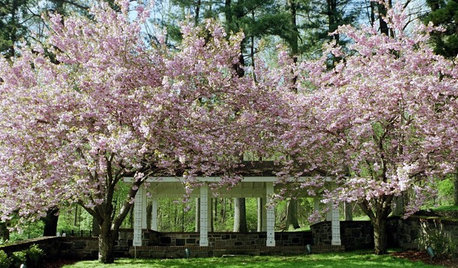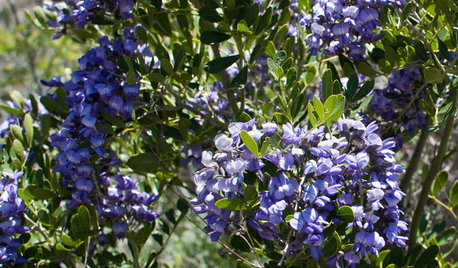Flowering Cherry Trees and Fruiting Cherry Trees Explained
parker25mv
8 years ago
last modified: 8 years ago
Featured Answer
Sort by:Oldest
Comments (21)
edlincoln
8 years agogardengal48 (PNW Z8/9)
8 years agoRelated Discussions
cherry tree without fruit
Comments (1)List of things: Could be poor pollination (cherries bloom early/not as many pollinators out). Blooms could have been destroyed by frost/freeze early on. Could be a bug (plum curculio love sweet cherries) that is laying eggs in the fruit/fruit are dropping prematurely. Could be disease? Birds could be eating them (they love cherries). Sweet cherries are difficult and have a lot of pest issues in the east. You'll probably have to spray if you want anything resembling a crop and then most likely net them (from birds). Are these sweet cherry or sour cherry? Sour cherries are really bright red (the ones i've seen) and sweets are dark red......See MoreCherry trees fruited last year, hardly any this year??
Comments (1)Frost around flowering time? Did you have flowers? Bad pollination? Maybe since the trees are so young and you got fruit so early, you taxed the tree and now its just saving energy for next time....See Morecan i graft a fruit cherry tree to a wild cherry tree?
Comments (20)I have read that in this instance that people can do two grafts. The native variety being the most hardy and strongest rooting, then a short intermediary piece which can bridge between the native and fruiting varieties. Can anyone assist? Or know someone who can? I have cut down a large native cherry and would like to graft lapins and stella to the sprouts which are sure to come up this spring. "example taken from plum/almond stone fruit grafting" - " Also (and this is where the fun starts) most fruit trees in the Prunus genus are sometimes compatible with each other: almonds, apricots, nectarines, peaches, and plums all are compatible for grafting, but occasionally it's complicated. For example, some plum rootstock is not compatible with peaches or nectarines; and some almonds require an intermediate step before grafting onto some plum rootstocks."...See Morenon fruit bearing cherry tree
Comments (5)The "big spikes growing on the side of the tree" may be from below the graft. If they have upright, non-weeping growth different from the original weeping cherry, that is certainly the case. These will very likely be of Wild Cherry (Prunus avium), which does bear fruit, though the cherries may be rather sour (though quite a lot of Wild Cherries do have very nice fruit, too). The flowers of Wild Cherry are single and white, not pink or double like the original, but still very attractive. Resin...See Moreparker25mv
8 years agoedlincoln
8 years agolast modified: 8 years agowisconsitom
8 years agoparker25mv
8 years agolast modified: 8 years agoUser
8 years agoEmbothrium
8 years agolast modified: 8 years agowisconsitom
8 years agoedlincoln
8 years agolast modified: 8 years agoparker25mv
8 years agolast modified: 8 years agoedlincoln
8 years agoEmbothrium
8 years agoUser
8 years agolast modified: 8 years agoparker25mv
8 years agolast modified: 8 years agobrandon7 TN_zone7
8 years agowisconsitom
8 years agoparker25mv
8 years agoEmbothrium
8 years agoIgor Viznyy
3 years ago
Related Stories

GARDENING GUIDESPlant Black Cherry Trees for the Birds and Bees
Plant Prunus serotina in the Central and Eastern U.S. for spring flowers, interesting bark and beautiful fall color
Full Story
EDIBLE GARDENSHow to Grow Your Own Luscious Cherries
Nope, they’re not the easiest fruit to grow. But with spectacular blossoms and pies as possibilities, cherries are sure worth a try
Full Story
EDIBLE GARDENSHow to Grow 10 Favorite Fruit Trees at Home
Plant a mini orchard in fall, winter or early spring to enjoy fresh-off-the-tree fruit the following year
Full Story
FARM YOUR YARDIf You Have Room for Only One Fruit Tree ...
Juice up a small garden with one of these easier-care or worth-the-effort fruit trees for a mild climate
Full Story
GARDENING AND LANDSCAPINGCrazy for Fruit Trees
Whether a single citrus or a mini apple orchard, even the smallest landscape space can bear deliriously delicious fruit
Full Story
EDIBLE GARDENSGrow Plum Hybrids for Your Favorite Fruit Flavors
Plums are cozying up with apricots, peaches and even cherries — here’s how to grow these hybrids for the best aspects of each
Full Story
SPRING GARDENING7 Spectacular and Practical Spring-Flowering Trees
Put on a beauteous show in the garden with a landscape tree awash in flowers — just do your homework first
Full Story
MORE ROOMSCherry Blossoms Spring to 100
This years marks the centennial of the beautiful trees' arrival on our shores. Below, a few ways to celebrate with your landscape and décor
Full Story
TREES7 Deer-Resistant Flowering Trees to Plant this Fall
If you live in a neighborhood with roaming deer, consider these beautiful trees that won't tempt hungry guests
Full Story
TREES6 Unsung Spring-Blooming Trees
Billowy blooms and rare fragrances will make you wonder how these flowering trees could ever have been underused in landscapes
Full Story





parker25mvOriginal Author